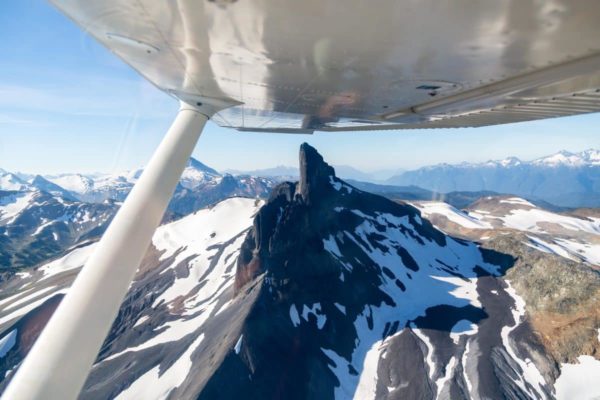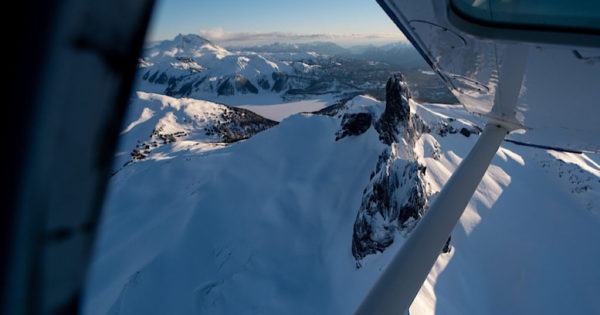One of the most well-known mountains of the Garibaldi Ranges in southwestern British Columbia, The Black Tusk lies within the Garibaldi Provincial Park; roughly 37km north of Squamish and 19km south of Whistler.
Black Tusk’s iconic upper spire is visible from a great distance in all directions and is most noticeable at various points along the Sea to Sky Highway from Vancouver to Whistler.
Whether for skiing, hiking, rock climbing or sightseeing, Black Tusk mountain is one of the most fascinating places in Canada to visit and tops the list of things to do in Squamish amongst locals and tourists alike.
The Black Tusk is the remnant of a much larger volcano that formed during two periods of volcanic activity between 1.3 and 1.1 million years ago, and sits within the northernmost reaches of the Canadian Volcanic Arc.
Natural Resources Canada have suggested the Black Tusk was “perhaps the conduit for lava within a cinder-rich volcano”, and that the “loose cinder has eroded, leaving only the hard lava core”.
To the indigenous Squamish people, the mountain is known as t’ak‘t’ak mu’yin tl’a in7in’a’xe7en. Translated, it means “Landing Place of the Thunderbird”; the jagged shape of the mountain and its black colouring are said to come from the supernatural Thunderbird’s lightning.


In 2011 a self-guided Sea To Sky Cultural Journey audio tour was created in partnership between the SLCC and Squamish and Lil’Wat nations. It was created for guests to enjoy while travelling the Sea To Sky highway. In the recordings the story is told of how Black Tusk came to have its original name.
“T’ákt’akmúten tl’a In’inyáxa7n refers to the massive supernatural bird whose enormous talons crushed this peak into its current shape.
Long ago Sk’ewk (Raven) was livid with Wexés (Frog). Sk’ewk picked up Wexés and carried him high into the sky. Wexés protested, demanding to be returned to the ground. Sk’ewk granted this wish by dropping him from the skies. As Wexés flailed, he grasped at the clouds tearing a large hole causing torrential rains which flooded the land.
This disturbed In’inyáxa7n (Thunderbird) who opened his eyes sending lightening across the land, flapped his wings causing havoc and destruction. Wexés landed in the rising floodwaters, nearly hitting Yéw’yews (Killer Whale).
Yéw’yews slapped his tail and thrashed about sending tidal waves in all directions decimating most remaining people. This series of events initiated the Great Flood – a universal story to many cultures.”
Due to its location in the Garibaldi Provincial Park, there are many other strikingly beautiful sights to take in when you visit Black Tusk mountain either by foot or air.
Here are just a few:
Arguably one of the most picturesque places in Canada, a glimpse of Garibaldi Lake, and its breathtaking turquoise waters set amongst volcanic mountains, is an experience all in itself.
https://www.instagram.com/p/BkQlQ_TDfOw/?utm_source=ig_embed
At a towering 2,676 metres (8780 feet), this triple summit mountain is one of the largest of the majestic peaks in the Garibaldi Ranges.
https://www.instagram.com/p/BHcr7ACACy4/?utm_source=ig_embed
Dominating the backdrop to the east side of Garibaldi Lake, Castle Towers Mountain was named due to its appearance by members of the BC Mountaineering Club after they made the first ascent in August 1911.
Mount Price is one of the three main volcanoes in the southern segment of the Garibaldi Volcanic Belt. Clinker Peak, a breached volcanic crater on Mount Price’s western flank was responsible for creating the Garibaldi Lake. At least three phases of eruptive activity have been identified at Mount Price, with the first event occurring 1.2 million years ago (at which time the Black Tusk was also active).
https://www.instagram.com/p/BKtGUCmg-1E/?utm_source=ig_embed
These eroding glaciers on the flanks of Mount Garibaldi are the two primary sources of inflow to Garibaldi Lake. Their mineral-rich glacier flour suspended in the melt water contributes to the lake’s exquisite turquoise hue.
https://www.instagram.com/p/BHAhcQujfNY/?utm_source=ig_embed
Sightseeing by air is the easiest way to see all of these sights in one go. And one major advantage of a birds-eye-view is that you get a much better understanding of the landscape’s geography, and the orientation of the mountains and features, than you would on the ground.
To help feed your curiosity, we’ve created this interactive map showing all the major sights around Black Tusk mountain.
View our full Black Tusk sightseeing map here on Google Maps.
Not for the faint of heart, the Black Tusk hike is approximately 18km return and is considered to be difficult due to the scramble over loose shale that is necessary as hikers approach the base of the Black Tusk. That being said, the views across the Tantalus Range to the south and of Whistler to the north are well worth the effort. If you don’t have time for a full-day hike you can hop on our 50-minute Whistler Backcountry Air Safari for spectacular aerial views of these amazing Squamish sights.
https://www.instagram.com/p/BLGLKC9gZRF/?utm_source=ig_embed
The Rubble Creek trailhead is the most direct and clearly marked trail, which is accessed via Highway 99. This trail is also favoured as it takes you past Taylor Meadows, which in the summer blooms with wildflowers, and Garibaldi Lake for a rest stop along the way.
There are two summits – the challenging scramble (false) summit is the one most often achieved, and offers those incredible sought-after views. The true summit is a technical climb requiring advanced skill and ropes.
Whilst the Black Tusk hike can be completed in one day, it is preferred to be done as an overnight hike; and either the Taylor Meadows or Garibaldi Lake areas are ideal for Black Tusk camping.
Important: reservations to camp anywhere in Garibaldi Park must be made, and fees paid, in advance via the BC Parks online reservation service or call centre.
Keep in mind that elevation gain for the hike is 1735 metres, and ensure that you have packed layers of clothing to protect you for the forecast conditions. Before you go, check mountain-forecast.com for the latest forecast on freezing level, temperatures, snow and rainfall, and sunrise and sunset times.
Sign up to our email newsletter (in the website footer) to get regular news, blog posts, and adventure inspiration for the Black Tusk, Garibaldi Provincial Park and the rest of the Sea To Sky Corridor.